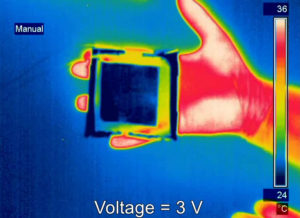
Scientists have created a graphene-based material that can outwit thermal cameras by masking hot objects. The film provides a layer of camouflage by appearing to match the ambient temperature, potentially making the object it’s covering seem invisible to the cameras.
The material combines graphene, nylon, gold and polythene coated with a liquid containing charged molecules. Applying just three volts to the film pushes the charged ions into the graphene, which reduces the infrared light that the material emits and increases how reflective it is. The film takes just a few seconds to adapt to the appearance of the ambient temperature, and it works at between 25 and 38 degrees Celsius (77-100 degrees Fahrenheit).
There are a number of practical uses for the material. The military, for instance, might be interested in how well it works during nighttime operations — a normal human body’s temperature is 98.6 degrees Fahrenheit, just inside the effective range. The researchers behind the material say it could be useful in adaptive heat shields for satellites, too. The rest of us, should we ever get to try out the material, will probably try to pretend we’re wearing an invisibility cloak straight out of Harry Potter.
This article originally appeared on Engadget.


